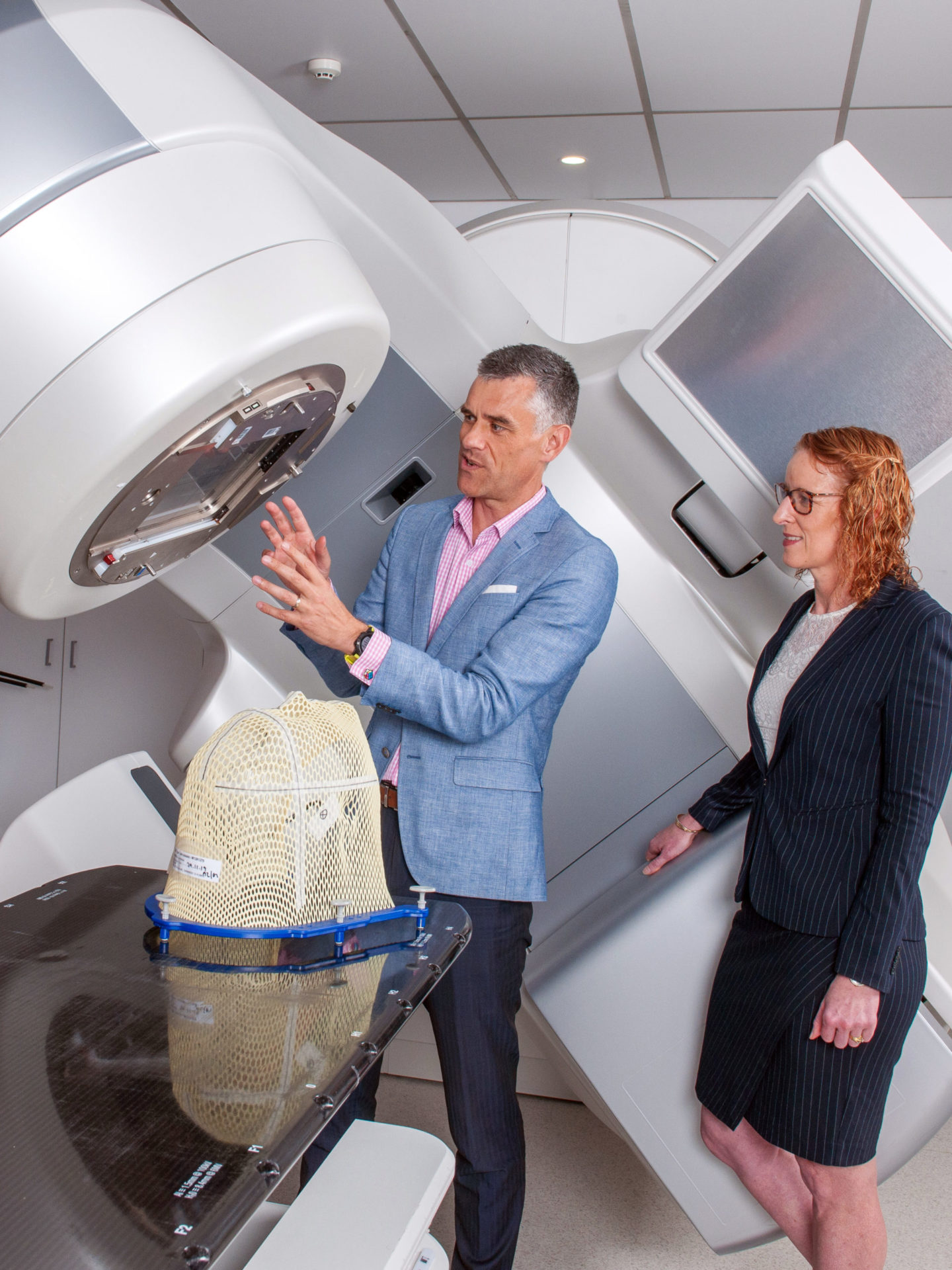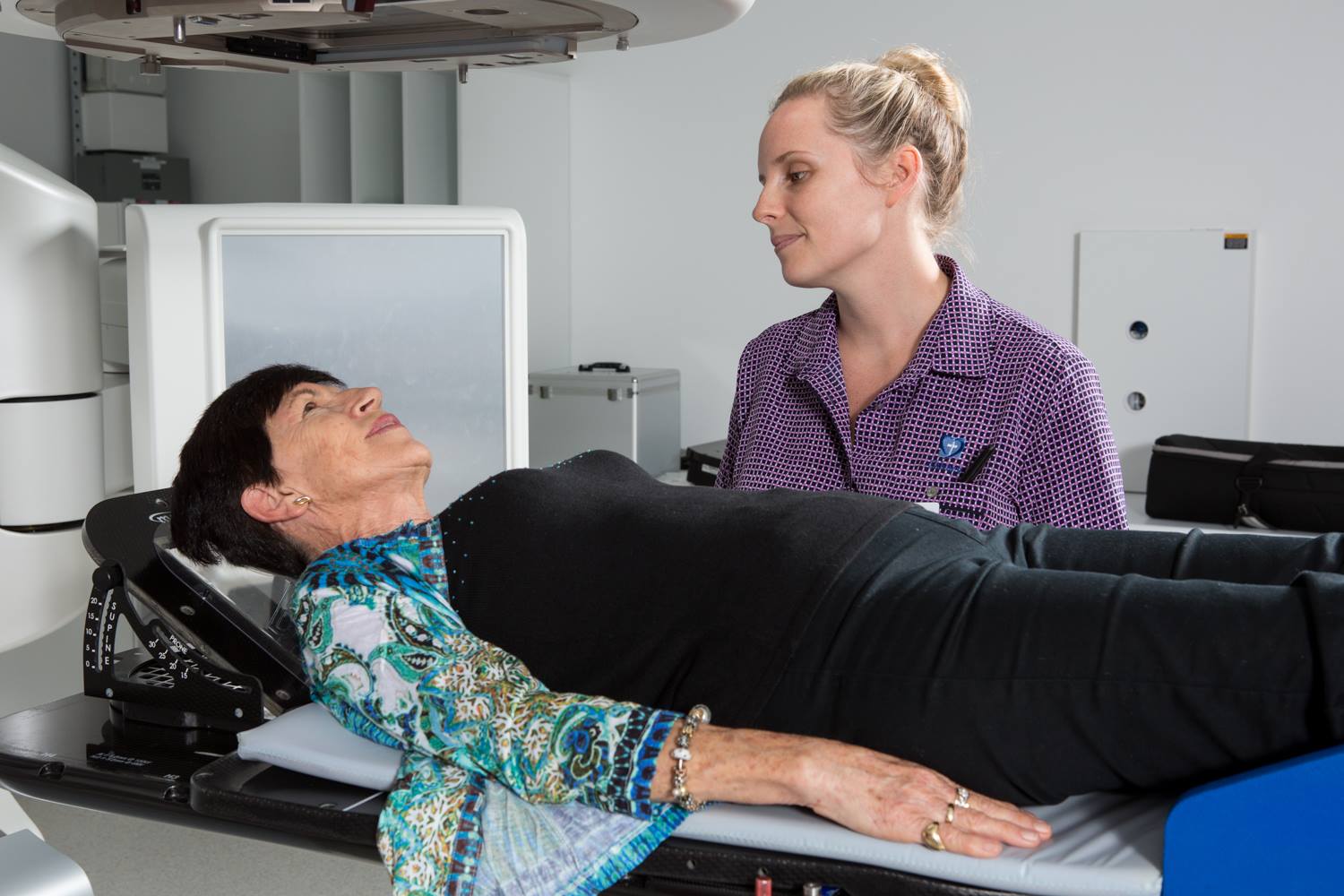
Radiation therapy, also called radiotherapy, describes the treatment procedure used to deliver high energy radiation to a precise target. Trained medical professionals, including radiation oncologists and health professionals (such as radiation therapists, medical physicists, nurses) use advanced technology to maximise radiation dose to the cancer target and minimise dose to healthy tissue.
In Australia, radiation therapy is an essential treatment option for patients diagnosed with cancer. In fact, one-in-two patients diagnosed with cancer could benefit from radiation therapy.
This treatment option has two equally important goals: to control the growth of the tumour and to do so while minimising exposure to the surrounding normal, healthy tissue.
Radiation therapy is used to cure cancer and it also has an important role in helping patients with advanced cancer that cannot be cured. Radiation can be used to shrink tumours, helping to relieve problems like pain, trouble swallowing, or bowel blockages. Known as palliative radiation, this treatment is all about improving quality of life.
This therapy can be applied safely to a wide range of cancers and may be used alone or in conjunction with surgery, chemotherapy, and other treatments. It is usually non-invasive and accessed through out-patient clinics.
To treat a cancer and attempt to prevent a recurrence by eliminating a tumour.
Before surgery to help shrink the tumour.
After surgery to treat any remaining cancer cells.
As a palliative treatment when eliminating the tumour is not possible (palliative radiation therapy is intended to relieve pain, pressure, and other symptoms by shrinking the tumour).
In combination with chemotherapy treatment as well as other drug therapies such as hormones and immunotherapy.
Radiation therapy is broadly divided into external beam radiation therapy (EBRT) and brachytherapy. Both techniques are used for treating a large variety of tumour types.
External radiation uses a machine that directs high-energy radiation from outside the body into the tumour. It’s done during outpatient visits to a hospital or treatment centre. It may be delivered over many weeks or through higher doses in a shorter period of time. A person receiving external radiation is not radioactive and does not have to follow special safety precautions at home.
A radioactive source is put inside the body into or near the tumour. With some types of brachytherapy, radiation might be placed and left in the body to work. Sometimes it is placed in the body for a period and then removed. This is decided based on the type of cancer. Special safety precautions are needed for this type of radiation treatment. But it’s important to know if the internal radiation is left in the body, after a while it eventually is no longer radioactive.
Radiation therapy uses high energy radiation to damage cancerous cells while minimising exposure to healthy tissue. Radiation damages the DNA in cancer cells, which interrupts their ability to reproduce, causing them to die and the tumour to shrink. Normal cells can recover from radiation more easily.
Treatment can be delivered to the target site via a range of different equipment and techniques, with one of the most common methods being a machine called a linear accelerator or linac. The linac generates a high-energy beam, which is delivered from many different angles, to target each part of the tumour and deliver the prescribed amount of radiation.
When designing a treatment plan, the medical team relies on one or more types of 3-D scans of your body. These can include a CT scan, an MRI, and/or a PET scan. By looking at these scans and other test results, the radiation oncologist and their treatment team determine the appropriate individualised treatment plan.
TROG Cancer Research is the largest radiation therapy clinical trial group in Australia and New Zealand. Over more than three decades, almost 15,000 patients have been enrolled in over 100 clinical trials. As a result, our research is having a significant impact on the way cancer is treated with radiation therapy.

The landmark TROG 03.05 MA.20 trial showed that after breast cancer surgery, treatment of both the lymph nodes and the breast with radiation can increase the time women remain cancer-free
The TROG 96.01 trial showed that the chances of cancer returning in the prostate could be reduced by approximately 60 per cent using a course of hormone therapy prior to radiation therapy
The TROG 96.06 trial showed that the risk of skin cancer recurring following lymph node surgery for melanoma could be dramatically reduced with a course of radiation therapy following surgery
the TROG 89.04 trial showed that the five-year survival outlook for sufferers of oesophagus cancer could be improved by up to five times using a treatment of concurrent radiation therapy and chemotherapy, compared to the standard treatments of either surgery or radiation therapy alone.
Our organisation consists of more than 1400 members involving an extensive network of cancer specialist doctors, nurses, radiation therapists, physicists, data experts and others conducting research across a wide range of cancers.
TROG Cancer Research is committed to promoting high quality cancer research, addressing scientific questions that matter and conducting cancer research trials nationally and internationally. We believe that clinical research is key to improving cancer care results and that patients enrolled in clinical trials have far better outcomes.